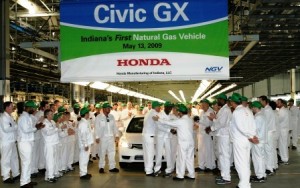The first Civics destined for export were shipped last week from the new Honda Manufacturing of Indiana plant (HMIN).The 2010 model Honda Civic Sedans will go on sale in Mexico, as well as 22 Latin American and Caribbean nations and U.S. territories of Puerto Rico, Guam and Saipan.
HMIN is Honda’s seventh auto assembly plant in North America and one of 16 major Honda manufacturing facilities in North America, including two under construction in North Carolina.
The Greensburg plant was dedicated in November 2008 just as the global Great Recession was taking hold after the collapse of Lehman brothers. Cutbacks at Honda production facilities ensued.
In its last quarterly report ending this past June, Honda’s global automobile sales totaled 766,000, a decrease of 20% from the same period last year. In Japan, unit sales amounted to 128,000 thousand units, the same level compared to the same period last year due mainly to favorable sales of Insight and Freed despite weak demand in the market. Vehicle sales outside of Japan decreased 24% to 638,000 from the corresponding period last year, due mainly to decreased vehicle sales in North America.
To cope with the drops in the U.S., Honda scheduled downtime, mostly Fridays off, late last year and into the summer this year. Inventories are now lower, partly as the result of Cash for Clunkers, which spurred small car sales and helped Civic and Accord models. Honda is now beginning to schedule some overtime production on Saturdays at its plants in Ohio and Alabama.
Unlike other manufactures, Honda did not eliminate any shifts or close plants during the past year. In fact, Honda has never laid off a full-time person in North America since it was the first Japanese maker to begin manufacturing operations here (of motorcycles) in September 1979. Car production followed three years later.
In general, Honda hourly associates during the Great Recession were given the choice of coming to work on non-production days and be paid for training and/or doing maintenance work; or they could use a vacation day and get paid; or they could stay home and not get paid.
Honda did institute salaried pay cuts, starting with top management, but didn’t specify the percentage trimmed.
During the last year more than 50,000 Civics built at the Greensburg plant were sold in the United States. Typically, a one-shift operation produces about 120,000 units. Greensburg has a planned capacity of about 200,000 vehicles. Though off to a slow start, it is now running a full shift at the integrated plant. Greensburg associates work on all aspects of vehicle production, including metal stamping, plastic injection molding, painting, sub-assembly and final assembly. Engines for Civics made in Greensburg are produced at Honda’s engine plant in Anna, Ohio.
“The United States remains the primary market for our Indiana-built Civics,” said Rick Schostek, Honda Manufacturing of Indiana vice president. “Manufacturing products for export broadens the experiences of our associates, contributes positively to America’s and Indiana’s international trade, and shows our commitment to the continued growth and evolution of our business in Indiana.”
Honda’s initial U.S. auto production for export occurred in 1987 when the Marysville Auto Plant in Ohio built Accords for shipment to Taiwan. Shipments to Japan followed the following year. Since beginning manufacturing operations in the United States 30 years ago, Honda has exported more than 3 million automobiles, light trucks, motorcycles, all-terrain vehicles and power products.
In May, Honda announced that the Greensburg plant had become the sole production source of the near-zero emissions, natural gas-powered Honda Civic GX Sedan.
Honda’s U.S. employment has remained relatively steady at around 27,000, where it has been for several years. Honda did offer a retirement incentive (not an early retirement, but an incentive) this year, so when final numbers are available after the end of the year, employment could drop. However, Honda is not releasing any figures at this time. Nor is it issuing a sales forecast, but scheduling overtime means it is increasing production, a positive sign for the economy.

